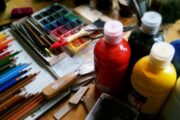Whenever you decide to immerse yourself in creating some type of artwork, you need to consider some essential aspects that will immensely impact your art. Beyond having the right idea that you want to express, you need to choose an appropriate surface that will align perfectly with the type of art you plan to make. Choosing the right type of surface plays a crucial role in influencing the texture, tone and overall aesthetic of your art creation.
To help you choose the ideal surface for your art, we’ve selected a few options that artists most commonly use. Let’s explore each of them separately, so you can get better acquainted with their features, which should help you select the right type of pad for the nature of your unique artistic vision.


